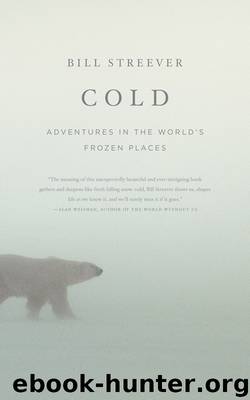Cold: Adventures in the World's Frozen Places by Bill Streever

Author:Bill Streever [Streever, Bill]
Language: eng
Format: epub
Tags: Science, History, Essays, Life Sciences, Ecology, Travel, Earth Sciences, SCI020000, Arctic regions - Description and travel, Essays & Travelogues, Polar Regions, Geography, Arctic regions
ISBN: 9780316042918
Publisher: Hachette Digital, Inc.
Published: 2009-07-22T15:02:32.494000+00:00
It is January ninth and twenty below at the Anchorage airport, close to the record cold set in 1952. The ground hides under four feet of snow, with plowed piles and drifts running deeper. Long icicles hang from roofs. El Niño, where have you gone?
I head south. By the time I fly over the Canadian border, temperatures on the ground are above forty. They hover in the forties for more than a thousand air miles, and then, as abruptly as a color change on a weather map, they reach the fifties. And by the time I land in New Orleans, the mercury flirts with seventy. I have flown across almost ninety degrees of temperature change.
For the most part, the flight path, at thirty thousand feet, took me through the troposphere. Puffy white cumulus clouds call the lower troposphere home. Cumulonimbus clouds can start down at the level of cumulus clouds, but they tower skyward as much as six miles, with updrafts that send pellets of water screaming toward space, turning to ice or snow as the air cools, then plummeting back down — not drifting down with gravity, but flushing down in rushed gusts. They roller-coaster up and down, sometimes freezing and thawing repeatedly, maybe eventually breaking loose to parachute to the ground as rain or snow or ice or undecided sleet. A cumulonimbus cloud can hold five hundred thousand tons of water.
For every mile upward in the troposphere, for every mile farther from the earth’s surface, the temperature drops seventeen degrees, plummeting to 65 below. But then it rises again in the stratosphere, warming up to the freezing point in the blanket of ozone that drifts around between nine and twenty-five miles up. Beyond, it cools back down. Around the fifty-mile mark, near what most would consider the edge of space, the thermometer drops to 180 below. At this temperature, carbon dioxide freezes solid. A few miles farther up, where the northern lights dance but still well below the realm of weather satellites and space shuttle orbits, the temperature rises. It exceeds 1,000 degrees, hot enough to melt lead and zinc, but in air so thin that it does not matter, in air so thin that it is not worthy of the name.
A hundred and fifty years ago, in England, not far from Westminster Abbey and Windsor Palace, a man named James Glaisher amused himself by sketching snowflakes. Not satisfied with what he found on the ground, he strapped a basket to the bottom of a balloon, loaded the basket with a drawing pad and an assistant, and rode it upward. In warmer clouds, reasonably close to the earth and ripe with humidity, Glaisher sketched the star-shaped flakes of Christmas cards. As he went higher, the air cooled. His assistant grew cold. The assistant’s hands, in particular, were chilled. Glaisher pressed on. The assistant, his loyalty guaranteed by the absence of any reasonable alternative to staying in the basket, stood by his side. Glaisher sketched hexagonal crystals of snow at five degrees above zero and column-shaped flakes at fifteen below.
Download
This site does not store any files on its server. We only index and link to content provided by other sites. Please contact the content providers to delete copyright contents if any and email us, we'll remove relevant links or contents immediately.
Welcome to the Goddamn Ice Cube by Blair Braverman(1608)
Iced In by Chris Turney(1584)
Arctic Dreams by Barry Lopez(1426)
The White Darkness by David Grann(1343)
Mawson's Will by Lennard Bickel(1150)
Big Dead Place: Inside the Strange and Menacing World of Antarctica (Large Print 16pt) by Nicholas Johnson(1121)
Caroline Alexander by The Endurance: Shackleton's Legendary Antarctic Expedition(1105)
The Stowaway by Laurie Gwen Shapiro(1038)
South Pole by Elizabeth Leane(984)
Mummies and Pyramids by Mary Pope Osborne(983)
Tip of the Iceberg by Mark Adams(981)
In the Kingdom of Ice by Hampton Sides(971)
Ice! by Tristan Jones(966)
Bound by Ice by Sandra Neil Wallace(966)
Home by Beth Powning(930)
The Ice Balloon: S. A. Andree and the Heroic Age of Arctic Exploration by Wilkinson Alec(904)
Ice Diaries by Jean McNeil(868)
The Snow Walker by Farley Mowat(837)
Future Arctic by Edward Struzik(821)
